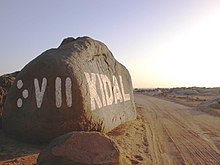
Back ቲፊናቅ Amharic Tifinagh AN تيفيناغ Arabic تيفيناغ ARY Tifinag AST Tifinaq Azerbaijani Tifinagh-Schrift BAR Либийска писменост Bulgarian Skritur berberek Breton Tifinagh BS
| Tifinagh | |
|---|---|
 | |
| Script type | |
Time period | 6th century BCE |
| Direction | Left-to-right, right-to-left script, top-to-bottom, bottom-to-top |
| Languages | Tuareg Berber language |
| Related scripts | |
Parent systems | |
Child systems | Neo-Tifinagh (20th century) |
Tifinagh (Tuareg Berber language: ⵜⴼⵏⵗ; Neo-Tifinagh: ⵜⵉⴼⵉⵏⴰⵖ; Berber Latin alphabet: Tifinaɣ; Berber pronunciation: [tifinaɣ]) is a script used to write the Berber languages. Tifinagh is descended from the ancient Libyco-Berber alphabet.[2] The traditional Tifinagh, sometimes called Tuareg Tifinagh, is still favored by the Tuareg people of the Sahara desert in southern Algeria, northeastern Mali, northern Niger, and northern Burkina Faso for writing the Tuareg languages.[3] Neo-Tifinagh is an alphabet developed by the Berber Academy by adopting Tuareg Tifinagh for use for Kabyle; it has been since modified for use across North Africa.[4][5]
Tifinagh is one of three major competing Berber orthographies alongside the Berber Latin alphabet and the Arabic alphabet.[6] Tifinagh is the official script for Tamazight, an official language of Morocco and Algeria. However, outside of symbolic cultural uses, Latin remains the dominant script for writing Berber languages throughout North Africa.[4][7]
The ancient Libyco-Berber script[8][9] was used by the ancient northern Berbers known as Libyco-Berbers,[10][11] also known as Numidians, Afri, and Mauretanians, who inhabited the northern parts of Morocco, Algeria, Tunisia, Libya, and the Canary Islands.
- ^ L'ECRITURE LIBYCO-BERBERE: Etat des lieux et perspectives
- ^ LBI LIBYCO-BERBER INSCRIPTIONS ONLINE DATABASE
- ^ Camps, G.; Claudot-Hawad, H.; Chaker, S.; Abrous, D. (1996-08-01). "Écriture". Encyclopédie berbère (in French) (17): 2564–2585. doi:10.4000/encyclopedieberbere.2125. ISSN 1015-7344.
- ^ a b Campbell, George L. (2012). The Routledge handbook of scripts and alphabets. Christopher Moseley (2nd ed.). Milton Park, Abingdon, Oxon: Routledge. pp. 58–59. ISBN 978-0-203-86548-4.
- ^ Cite error: The named reference
:9was invoked but never defined (see the help page). - ^ Soulaimani, Dris (2016-01-02). "Writing and rewriting Amazigh/Berber identity: Orthographies and language ideologies". Writing Systems Research. 8 (1): 2–5. doi:10.1080/17586801.2015.1023176. ISSN 1758-6801. S2CID 144700140.
- ^ Cite error: The named reference
choicewas invoked but never defined (see the help page). - ^ "Libyco-Berber – 2nd (9th?) century BC-7th century AD". Archived from the original on 2022-06-05. Retrieved 2022-06-04.
- ^ Written in stone: the Libyco-Berber scripts
- ^ Libyco-Berber relations with ancient Egypt: the Tehenu in Egyptian records
- ^ History of Humanity: From the seventh to the sixteenth century. Edited by Sigfried J. de Laet